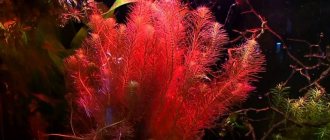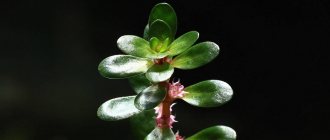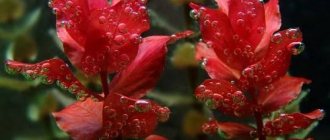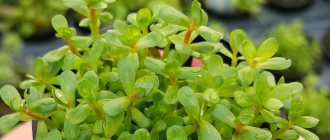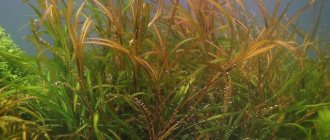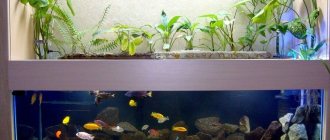Rotala belongs to plants of the loosestrife family. Grows in China, southeast Asia and India. It is grown in greenhouses and aquariums. Rotala grows quickly. In good conditions, it can grow up to 20 cm in a month. It reaches a height of 25-50 cm.
The plant looks like this: small narrow leaves grow on a high stem, their edges may be slightly wavy. The color of the leaves depends on the type of plant, the installed lighting and the water temperature. The root is creeping, poorly developed. In an aquarium, depending on the species, rotala is used as decoration for the background, middle and even foreground.
general description
Rotals naturally grow in the tropical zone, but are most common in southeast Asia. This plant has a long stem and numerous leaves of different shapes, mostly needle-shaped. Some varieties have very interesting beautiful colors.
They are usually erect plants 25–50 cm long, but creeping varieties are also found among them. In an aquarium, they can float in water, but they look most impressive when planted in the ground.
Main types of rotala
There are many varieties of these aquatic plants known among aquarists. Let's look at the most popular of them.
Indica (Indian, round-leaved)
Rotala is the easiest to maintain and has a high growth rate.
Macrandra (large-stamened)
These aquatic plants are difficult to maintain.
Several varieties of makrandra are used in aquariums:
- red (large-stamened) - one of the most beautiful rotals with an average growth rate, this spectacular plant with oval leaves of bright pink-red flowers grows 25–30 cm in length and 5–7 cm in width;
- green - does not look so impressive, but is less capricious in its maintenance, only it does not tolerate transportation very well; an adult green macrandra usually grows up to 50 cm in length and up to 3 cm in width;
- narrow-leaved - has a red-pink color of narrow leaves and grows to the same size as the previous variety, moreover, it has many side shoots;
- “tiger” - has red wavy leaves with veins, stem length up to 50 cm;
- green angustifolia - similar to ordinary angustifolia, but it has only green tones in color;
- mini - grows no more than 20 cm in length, very tender and brittle.
Wallichha (Walcha)
It is a long-stemmed plant with long, needle-like herringbone leaves, growing about 30 cm long. The narrow leaves grow to 1–1.5 cm, and their color is very dependent on water. Under the right conditions, very beautiful pink tones can be achieved.
Rotundifolia green
This rotala has light green color narrow leaves about 2 cm long.
The plant itself can grow up to 50 cm and is very branched, forming flowing dense shapes similar to a hat.
Bangladesh
This rotala has narrow green leaves, the top of which is pinkish in good light. It grows up to 20 cm and is relatively unpretentious.
Perls
A rare small-leaved plant in the aquarium hobby, difficult to maintain. It grows up to 30–40 cm and has small curling green leaves, the lower part of which has a purple tone.
Butterfly
It became known to aquarists quite recently, but has earned appreciation due to its small size and bright red color of small oval leaves. She looks great in the foreground. Very thermophilic.
Nanyenshan
It is similar in appearance to Wallich rotala and green rotundifolia. It has thin long leaves, growing up to 2–3 cm, a somewhat creeping or inclined stem, growing up to 30–40 cm. In good light, it acquires a beautiful golden color with reddish tones and spreads better.
This rotala with narrow long leaves appeared recently, so it is still rare. Its long stem has rich red tones, and its greenish leaves, under good conditions, can turn golden brown to pinkish in color.
Maca ed.
Another less common long-stemmed aquarium plant with narrow, thin leaves. Its color depends on the conditions of its maintenance, and the leaves can acquire pinkish tones.
Myanmar (Mayanmar)
It grows up to 20 cm long, has thin leaves up to 2.5 cm. The color depends on the conditions of detention and can vary from golden-red to red-brown tones. This is a rare plant, demanding on its growing environment.
Rotala Bangladesh
Rotala Bangladesh
Rotala Bangladesh
The habitat of the Bangladesh rotal is the water bodies of South Asia. This plant is most often found in Bangladesh, which is how the plant got its name. This type of rotala appeared on our market relatively recently, but the plant has already gained popularity among aquarists due to its decorative appearance. Despite the fact that the plant is unpretentious, it is still quite rare to find it in the collections of aquarists.
Rotala Bangladesh has narrow green leaves. The top of the plant becomes reddish in color when exposed to intense light. The root system, like all rotals, is weak. The plant can be grown either free-floating in the water column or planted in the ground. The second is preferable, since in this case the rotala will look much more beautiful. In aquarium conditions, the height of the bush reaches 20 cm.
Unlike other species of Rotal, rotundifolia is a relatively undemanding species in terms of keeping conditions. Suitable only for aquariums with a water temperature of at least 24 °C. At lower temperatures, the growth rate of this plant decreases significantly and the plant degrades.
Rotala large-leaved feels best in soft water with a hardness of no more than kH 4-7°. Preferably with a neutral or slightly acidic active reaction - pH. At a pH of 6.5–6.8, the underside of the upper leaves turns purple.
The water in the aquarium must be clean - without excess suspended matter and nitrogenous compounds, so good filtration and regular water changes are required.
Lighting should be moderately bright or bright 60-100 Lm/l. With a lack of lighting, the plant stretches out and looks weak and loses color. Excessive lighting can lead to the appearance of algae, which destroy it. Therefore, lighting is selected individually. The duration of daylight hours should be about 8-12 hours.
Rotala of Bangladesh has a poorly developed root system. The plant can be planted in the ground, or it can be left floating in the water column. A plant grown in soil has enough natural sludge to feed it. A floating plant that receives nutrition only from water.
It is also interesting that Rotala has many different shapes and types, for example:
Rotala macrandra green
Rotala macrandra green narrow leaf
Rotala macrandra mini type 2
Rotala macrandra narrow leaf
Rotala macrandra variegated
In general, the rotal family, like many other aquarium plants, is extensive, here is a small list:
Rotala sp.Wayanad. Rotala sp Hong Kong Rotala Hong Kong. Rotala Singapore Rotala Singapore. Rotala sp. 'Enie' Rotala Enie Rotala maka red Rotala maka ed. Rotala Magenta Rotala Magenta. Rotala sp. Ceylon/Rotala sp.Pink. Rotala macrandra sp. Florida. Rotala macrandra Butterfly Rotala Butterfly. Rotala wallichii sp. Vietnam. Rotala perls.
Rotala sp. "Bangladesch" by Rotala Bangladesh. Rotala mini Type II (Rotala macrandra “Mini Type II”). Rotala Goias. Rotala macrandra. Rotala macrandra variegated.
Rotala Indica.
Rotala video review
Cool videos about plants from FanFishki
Subscribe to our YouTube channel so you don't miss anything
PRACTICAL NOTE ON GROWING AQUARIUM PLANTS
This note is posted in all FanFishka articles dedicated to aquarium plants. This is a cheat sheet with a link that will help you grow any aquarium plant and herbalist of any complexity.
Most of the reference materials are located in the Aquascape , we also recommend our brochure: Aquarium navigator for beginners: “Underwater Gardens of Babylon” .
The formula for success in growing plants can be depicted as follows.
First of all, the proper level of lighting is necessary.
(light intensity - Lumens)
Next, the proper concentration of CO2
Further macro-fertilizers and micro-fertilizers
Water parameters, care and quality water changes
The gradation of this formula is based on the degree of importance. Lighting intensity is primary, and then descending. Therefore, if your plants have holes in the leaves, they have sciatica (crooked) or there are problems with algae, then please do not read the “bad advice” - this is chlorosis (lack of iron), this is a lack of potassium... diarrhea, phimosis and endometriosis )
You always need to solve the problem of setting up an herbalist from major to minor. Plants will die more quickly from a lack of lighting than from a lack of Fe and K. Moreover, the latter are always present in one degree or another in the aquarium, but it is difficult to measure their precise value.
Below, let's go from the main to the minor.
Lighting in an aquarium with plants . Remember, the most important thing in light is its intensity (Lumens)! All other lighting characteristics: spectrum, Kelvin, PAR/PAR, Ra... are important, but secondary. There will be no intensity of lighting, there will be nothing. At the same time, the lighting intensity must be balanced - selected specifically for your project (height of the water column, number and types of plants, daylight hours).
Based on the above, choose aquarium lighting primarily by the number of lumens, and then everything else.
Lighting is the most expensive part. The most budget-friendly solution is to install ordinary construction-street floodlights above the aquarium . Fortunately, they are now very thin and aesthetic. And believe me, under them everything grows with a bang, of course, provided that all the other components are present.
In order not to be unfounded, here are photos of our herbalists, which were grown exclusively under LED spotlights or with their presence.
If you want professional lighting or aesthetics. Then you will have to fork out some money. The amounts can vary quickly from 10,000 to 50,000+ rubles for a 100 liter aquarium. For example, in 2021 we switched to professional lighting - ISTA Titan . Yes, not cheap, but the lamps are Achon! We have grown a professional competitive aquascape under them. That’s why we advise you to pay attention to them.
Well, it’s difficult to advise anything, because... Everyone has different needs and capabilities. In this article we talk about the products of our partners - Tetra , Laguna , ISTA lighting .
We tried to briefly and objectively talk about them. Then it's up to you. In any case, we do not really recommend that you pay attention to handicraft lighting assembly from folk craftsmen. Not all, but as a rule, they shove who knows what kind of diodes into such an assembly, assemble it all on their knees... and believe me, more than once on the forum you hear echoes of the consequences of such a purchase. After all, a company is a company. At a minimum, you are given warranty and post-warranty service.
If you are a beginner, your first herbalist, then LED spotlights are your choice. Let's move on, otherwise this note isn't very short =)
CO2 for aquarium plants . The plant is approximately 90% water, the remaining 10% is dry matter. Of that 10%, 46% is carbon. This is why CO2 supply is so important in a planted aquarium.
Plants in an aquarium obtain carbon “from water” - from carbon-containing compounds. But the natural concentration of C-carbon in water is small and is only sufficient for unpretentious plants, but they, and even more so, will be happy with additional carbon feeding. The supply of CO2 can be provided using mash or a CO2 balloon system , lemon juice or other methods.
The best, professional, simple and budget option is to supply carbon dioxide through a cylinder. One thing, however, is the initial purchase of a set: a cylinder, an MG valve, a diffuser…. will hit the budget.
Is it possible to do without CO2, but for a couple of bushes of simple plants ( cryptocorynes , echinodorus , most ludwigias , etc.).
What balloon systems can you recommend? The most budget option is an assembly from craftsmen who sell CO2 systems in VK and on forums. Everything is very high quality.
If you want a branded item, then we recommend the most inexpensive and at the same time high-quality CO2 systems from ISTA (Taiwan) . We have been using them for 5 years and recommend them to you.
On sale you will find two series of ISTA Aluminum CO2 Cylinder cylinders, with horizontal and vertical threads of 1 and 3 liters.
Fertilizers for an aquarium with plants . All fertilizers, of any brand, can be divided into MACRO-FERTILIZERS and MICRO-FERTILIZERS .
Macro fertilizers are nitrate NO3 and phosphate PO4 from which plants take N-nitrogen and P-phosphorus. These are the most important elements after CO2 - C-carbon.
Remember - Redfield's proportion rules . Always keep it under control and everything will be ok. Right, based on our observations, Redfield’s proportion rules only in full NPC proportions. Incomplete proportion - without carbon C does not give good results.
Micro fertilizers . These are all the other less important elements that are necessary for plants (see link). There is no point in putting too much emphasis on them. Firstly, all of them are contained in one quantity or another in tap water and are restored in the aquarium with changes. Secondly, an overdose of micro very quickly leads to an outbreak of algae.
A common mistake made by beginners is not understanding what they are pouring into the aquarium. For example, let's take such a popular and popular fertilizer as Tetra PlantaMin . Read the product summary at the link - it strengthens, stimulates, and gives a chic body shape.
A beginner, without delving into the essence, uses it and gets an outbreak of algae, writes on the forums - “Like, wow, what a bad Tetra.” And the trouble lies not in the drug, but in a lack of understanding of the nitrogen cycle and balance in the herbalist . The beginner has a Redfield bias (let’s say N and P are generally zero) and instead of making up for the lack of these primary elements, he fills the aquarium with Tetra PlantaMin - a micro-fertilizer (iron, potassium, manganese). As a result, going over the micro is only detrimental, because... plants lack the base - nitrogen and phosphorus.
Thus, you must understand what plants lack and understand fertilizers.
How to understand what plants lack? It's simple. Now the market is filled with a variety of expensive and not so expensive aquarium water tests. We recommend inexpensive domestic ones - VladOx drop tests , they are sold online and offline.
We also recommend, let’s not be afraid of this word, innovative domestic UHE tests . They are currently only sold online.
The minimum set of tests for an herbalist is NO3 and PO4. It is advisable to have the entire nitrogen range: NH4, NO2, NO3. As well as kH and pH tests.
Tests help us monitor the situation in the herbalist, but over time it is advisable to learn to see and feel the aquarium for yourself. With experience you need to move away from “convulsive testing”; the best aquarium test and tool is ourselves.
Let's summarize this part. Macro, it’s macro in Africa too. The link above generally contains a recipe on how to make them yourself. If you are not yet ready for self-mixing, then always and everywhere you will find a line of fertilizers from Tetra: Tetra Planta Macro , Tetra PlantaMicro , substrates, root tablets and much more .
Of course, there are many other brands that produce aquarium fertilizers. There is an opportunity, use even ADA products. All markers are different in taste and color. The main thing is to use it with a clear understanding of what you are using it for and what you want to get in the end.
From the professional line of fertilizers, at an adequate price, we can recommend Prodibo (soils, soils, macro, micro, stimulants, etc.).
So, something like a note turns into the Talmud. Which is not surprising - the topic is very broad. One moment left.
Water parameters for aquarium plants. Link1 and Link2 , please look at these articles, they cover the essence quite well.
Here we note that the quality of photosynthesis is influenced by the process of caring for the aquarium: water parameters (kH, pH below 7), high-quality filtration and aeration, competent and timely water changes.
Please study
How to properly keep rotala in an aquarium
Most rotals are very picky about their living conditions.
The necessary conditions
In order for rotals to show themselves in all their glory, they should create a certain environment.
Temperature
When keeping rotala, it is necessary to ensure a temperature regime of the aquatic environment of at least +24 °C. Lower temperatures lead to slower plant growth.
Lighting
Rotala prefers moderately bright lighting. With a lack of sunlight, it loses its beautiful appearance - it stretches out and turns pale. The plant normally withstands only slight shade. In favorable light conditions, rotala leaves have pinkish or golden hues.
Daylight hours should be approximately 12 hours. In winter, when daylight is short, it is necessary to provide artificial lighting using a fluorescent lamp or incandescent lamp, which is placed next to the aquarium.
Water requirements
The water in the aquarium must be soft or slightly hard (gH no more than 6). If the hardness is exceeded to 12, the rotala may wither. The required acidity of the aquatic environment must be neutral or low acidity.
This aquatic plant does not tolerate an alkaline environment well. Rotala loves clean water, so changes should be done regularly (20–25% of the total volume of water), filtration and aeration should be ensured. Dirty water has an adverse effect on the development and appearance of the plant.
It is necessary to ensure that algae does not appear in the water - they spoil this plant. You should also monitor the water level: it should be sufficient for the rotala to be completely submerged.
Priming
Rotala is completely undemanding when it comes to soil selection. Moreover, having a weak root system, it can develop in the water column. But it is worth considering that rotala planted in the ground has a more beautiful appearance, since it receives more nutrients from the soil than simply floating in the water.
Pebbles with the addition of peat or clay are excellent for soil. For a weak root system of the plant, about 3 cm of soil in the aquarium is sufficient.
Useful lifehacks
To provide the plant with competent care, we recommend using the advice of experienced aquarists:
- Xenococus - colonies of single algae are very dangerous for Rotala Wallihi. Even a small amount can kill the plant. Therefore, you should regularly change the water in the aquarium.
- To achieve a bright and rich color, it is important to follow several rules. The CO2 concentration should be high - from 20 to 30 mg/l, pH level - within 6.5. Regular supplementation with iron is also important. With a general hardness above 6°, although the plant’s growth stops, the leaves acquire a burgundy tint. When the total hardness is less than 6°, they become crimson. To obtain a bright purple hue, the concentration of nitrates should be reduced to less than 10 mg/l, and the amount of phosphates should be reduced to 0.5 mg/l.
- Rotala Wallicha reacts poorly to haircuts. After cutting off the upper part of the stem, the lower part branches reluctantly, and sometimes even dies off. Therefore, for the purpose of propagation, it is advisable to cut it at a time when the stem has already produced a lateral shoot. It is advisable to compact the group by planting cut stems.
- The optimal distance between plants is from 2 to 4 cm. This helps to avoid the accumulation of algae on the leaves.
- Since Rotala Wallichha has a poorly developed root system, after planting in the ground, the rooting site can be fixed with small stones.
How to properly care for a plant
To feed rotala, you can use mineral fertilizers in small quantities. Some varieties are demanding of iron-containing fertilizers, which are necessary for color intensity. To prevent these algae from growing too much and filling the entire aquarium, you need to periodically thin out and trim them.
Rotala grows quickly, gradually exposing part of the stem at the bottom, so as necessary, plants need to be updated and replaced with young specimens.
Reproduction of Rotala
The plant propagates mainly by cuttings. To do this, carefully cut a part of the stem 7 cm long and plant the separated piece in the ground. After a while, the plant puts out small roots and adapts to a new place.
It is advisable to maintain temperatures up to +30 °C during this period and be sure to provide bright lighting. When propagating in a greenhouse, part of the stem is planted in soil, covered with water on top.
In this case, rotala shoots shoots with glossy leaves above the water and after a while begins to bloom. When the necessary conditions are created, the plant grows quickly. In a greenhouse, humidity should be high, water and air temperatures should be in the range from +26 to +30 ° C, and the lighting should be quite bright.
Rotals look very impressive in aquarium design, thanks to their interesting colors. However, in order for them to fully show their beauty, it is important for them to create the necessary conditions. These plants are not for beginners, although there are less finicky varieties among them.
This warm and light-loving plant from the tropics with a long stem and small thin leaves looks most beautiful in groups. They are usually used to decorate the background and middle background in an aquarium, which looks very beautiful, especially when backlit.
Distribution in natural conditions
The rainbow beauty can rightfully be called an endemic, since its distribution area is quite narrow. Two subspecies of this fish have been noted:
- The first is found in the southern part of the island. New Guinea, its representatives have a brighter color.
- The second subspecies is common in the northern part of Australia and is distinguished by its silvery scales.
Scientists first described Iriatherina werneri in 1974 based on individuals that were caught in a small river in the south of the island. New Guinea. For some time it was believed that these fish were not found anywhere else. However, in 1978, a similar species was discovered in a reservoir in Northern Australia.
Iriaterins prefer slow-moving rivers and streams, small lakes and creeks. They love to frolic in clean, warm water among aquatic vegetation and swim in the upper layers of reservoirs (0.5 to 2 meters deep).
Under natural conditions, fish feed on phytoplankton, small algae, and single-celled organisms. The lifespan in nature is 5-6 years, and in aquarium conditions - no more than 4 years.
Rotala macrandra: content, description, reproduction, photo
Rotala macrandra from the loosestrife family is one of the most beautiful long-stemmed aquarium plants. Several hybrids are united under this name, the most popular among which are rotala makrandra, rotala macrandra angustifolia, rotala macrandra green, rotala green makrandra angustifolia.
The most impressive and spectacular of them is the rotala makrandra. Thanks to the rich red color of its unusually thin oval leaves, rotala will decorate any aquarium with its presence. However, please note that while being one of the most beautiful, this plant is also one of the most whimsical. Therefore, before you decide to use rotala to decorate your aquarium, think about whether you are ready for this important step.
Benefits for the aquarium
This is a graceful, actively growing herb. It looks impressive as a plant on its own, emphasizing the structural depth of the background of the aqua zone, and can be used to create aesthetically attractive underwater compositions.
Rotala affects the hydrochemical characteristics of the aquatic environment:
- absorbs nitrogenous and other compounds;
- saturates water with oxygen;
- becomes a haven for bacterial flora, which is a natural aquarium filter.
It creates favorable conditions for the life of fish and other inhabitants of the artificial biocenosis. Fry and adults can hide in the thickets; the foliage serves as an additional source of food for some of them.
Description
Rotala macrandra is an aquarium plant native to India. In its homeland, it can be found growing along the coast in silty soils. A long-stemmed plant, it grows straight up under water, turning bright red. Above the water it spreads along the surface and turns green. The plant reaches a height of 20-30 cm and is often used in nano aquariums as a background plant.
Despite the fact that rotala makrandra is a rather difficult plant to maintain, it is quite easy to purchase and the price is quite low.
In addition to the traditional standard sample of rotal macrandra, other varieties of this plant are also known:
- Rotala macrandra “green”;
- Rotala macrandra “narrow leaf”;
- Rotala macrandra “variegated”;
- Rotala macrandra “green narrow leaf”;
- Rotala macrandra sp mini
General information
Indian rotala (rotala indica) is an ornamental plant of the loosestrife family , belongs to the genus Rotala, family Lythraceae, belongs to the order Myrtaceae, class Rosida, department Angiosperms.
Rotala grows in Transcaucasia and Southeast Asia. In indoor conditions, the height reaches 30 cm. The brown leaves with a red tint are located opposite each other in ring-shaped nodules along the entire trunk. Sometimes they take on a purple tint. Leaf dimensions: width 3 mm, length 10 mm.
Depending on the type of rotala, two, three or four leaves appear from one whorl. Experts especially value wide-shaped sheets. Since the top of the grass and side shoots grow at an accelerated pace, the lower ones receive little light, turn pale and fall off. To avoid this, it is recommended to regularly thin out the grass, leaving young shoots.
The aquarium plant Indian rotala attracts with its unusual properties. In water, rotala leaves have an elongated shape, while those that look out of an aquarium or grown in greenhouses are round. When the lighting is correct, the underside of the green leaf takes on a red tint.
Contents of Rotala
In home aquariums in the post-Soviet space, Rotala is rare, and this is primarily due to the low level of information among domestic aquarium enthusiasts about this plant, as well as the difficulty of keeping this plant.
Temperature. To keep rotala, the temperature in the aquarium must be maintained in the range from 22 to 28 ° C, and priority should be given to the upper bar.
Lighting. Rotala requires bright lighting because... in bright light, the leaves will take on a reddish, more decorative hue. The light period should be at least 12-14 hours a day. Exposure to sunlight is allowed, but not more than 3 hours a day. With a lack of light, the rotala stretches out and looks weak and pale.
Water. Water for Rotala should be soft with the presence of peat (a peat filter can be used). We perform water changes every two weeks up to 30% of the aquarium volume. Monitor the water level in the aquarium; the level should not be lower than the plant (the plant should always be in water).
Priming. For normal growth of rotala, the soil in the aquarium must be natural, nutritious and without dyes. Various pebbles with the addition of peat or a small amount of clay are suitable as soil. It is enough to fill the aquarium with soil up to 3 cm, since the rhizome is weak and small.
Fertilizer. For rotala, the use of mineral fertilizers is allowed, but it is important to remember that the dosage should be two times lower than for other plants.
Important! The plant can only be planted in areas with weak currents - the rapid flow of water can damage its fragile leaves or tear it out by the roots.
Compatibility
Not all plants can be planted in a community aquarium. You should also not plant Ludwigia in containers with certain types of fish. For example, it is not recommended to grow this crop in an aquarium where there are fish that like to burrow in the ground. These include, for example, cichlids. Such fish, with their habit of digging in the ground, can damage the rhizome of Ludwigia, which will negatively affect the development of the algae.
As for other types of herbs, you should select plants whose maintenance conditions are similar to those for ludwigia. So, this culture loves bright light, and this is not always good for other plants
In addition, it is important to plant herbs in the aquarium that will not grow too much and block the light for the ludwigia. Avoid large-leaved green spaces. In addition to its decorative function, ludwigia also has a practical function.
For example, it can become a refuge for schools of fry or small fish such as guppies, gourami, and mollies. Some aquarium inhabitants are not averse to eating its healthy leaves, enriched with vitamins.
In addition to its decorative function, ludwigia also has a practical function. For example, it can become a refuge for schools of fry or small fish such as guppies, gourami, and mollies. Some aquarium inhabitants are not averse to eating its healthy leaves, enriched with vitamins.
Reproduction
Rotala, like all long-stemmed plants, is characterized by propagation by stem cuttings. The length of the cuttings should be at least 7-10 cm, otherwise they will grow extremely slowly. If you take a cutting from the middle part of the stem for propagation, make sure that it has formed a side shoot.
When performing any manipulations with the rotala, do it very carefully. Its delicate leaves react poorly even to a light touch of fingers. Therefore, when replanting, try to minimize the time the plant spends in the air.
If you are growing rotala in a container with a low water level, make sure that its top is not above the surface. Ground shoots, once exposed to air, will quickly lose their decorative properties. Also, once out of the water, the plant may bloom, which will also not have the best effect on its appearance.
Treatment and prevention of diseases
The first time after transplantation is considered a dangerous moment for the development of diseases. The plant is transported from greenhouse conditions to an unusual environment, experiencing stress
It is important at these moments to provide the rotala with normal conditions. In addition, ailments are provoked by water, which does not provide the necessary microelements and poor-quality soil.
The first signs of disease appear immediately, the plant changes color (turns pale) and becomes lethargic. Infected and rotten parts are removed as soon as possible using tweezers.
To protect against algae, it is recommended to regularly clean the aquarium and refresh the water. In addition to them, roots exposed to the air (during transplantation) and careless touching with fingers are dangerous.
Appearance
The leaves of rotala red-leaved are ovoid in shape with wavy edges and reach sizes up to 5 cm in length and 4 cm in width, located on a long stem opposite each other. The underside of the leaf is painted purple, but the color of the upper side varies from red to green. Rotala macrostamen has slightly branched, long stems, growing vertically and reaching up to 20-25 cm in length. The rhizome is creeping with a large number of leaf buds. The plant blooms with small pink flowers.
Large-stamen rotala is a real decoration of the aquarium. The lacquered, oval leaves of purple color make this variety of rotala red-leaved one of the most beautiful among aquarium plants. Plants should be placed in groups on the side or foreground of the aquarium. Just the groups should not be too dense, otherwise the lower leaves will be in the shadow of the side shoots.
Interesting facts and tips
- This plant was discovered in nature in 1799 and was originally called Indian peplis. A century later, the German scientist Koehne attributed it to the “rotala” genus.
- The name of the plant comes from the Latin word “rota”, which means “wheel”, because this is how, in the form of miniature wheels, whorls with leaves are located on the stem.
- Small pink flowers are formed only in plants that breathe atmospheric air. But aquarists are not particularly upset about this - the flowers do not have any decorative value.
- If you direct the illumination of the aquarium to the back wall, where the Indian rotala is planted, you can get a very beautiful vibrant red background for all the other underwater inhabitants.

